Abstract
OBJECTIVE: To review a series of farm injuries in the parkland region of Manitoba, compare the collected data to similar studies, and provide a baseline for deriving effective preventive measures for the local community. DESIGN: Retrospective case study involving review of hospital charts. SETTING: The population studied was derived from the catchment area for Dauphin General Hospital, a referral centre servicing an agricultural region of 57,000 people. PATIENTS: Seventy-two patients were admitted to hospital between January 1981 and December 1991 after being injured by agricultural machines, farm animals, herbicides or other chemicals, and fertilizers. Four fatalities were identified through a review of local medical examiner records, for a total of 76 cases. MAIN OUTCOME MEASURES: The following data were abstracted for each case: sex, age, time and date of injury, cause, type of injury, and body part involved. RESULTS: Most cases involved men, between the ages of 20 and 69, during the afternoon and early evening with a seasonal peak in late summer. More than 60% of injuries were caused by agricultural machinery, followed by animal-related injuries (25%). Grain augers were the most common type of machine causing injury (35%). All patients younger than 9 years were female, and 75% of their injuries involved farm animals. A decreasing annual frequency of farm injuries was noted over the 11-year period. Fewer accidents involving farm machinery appear most responsible for this trend. CONCLUSIONS: Many agriculture-related injuries occur in the parkland region of Manitoba. The type and pattern of injuries observed resembles those documented in other studies. With effective education and preventive measures, most injuries and fatalities could be prevented. Physicians are obliged to encourage and support educational programs in their communities and to review safety practices with patients.
Full text
PDF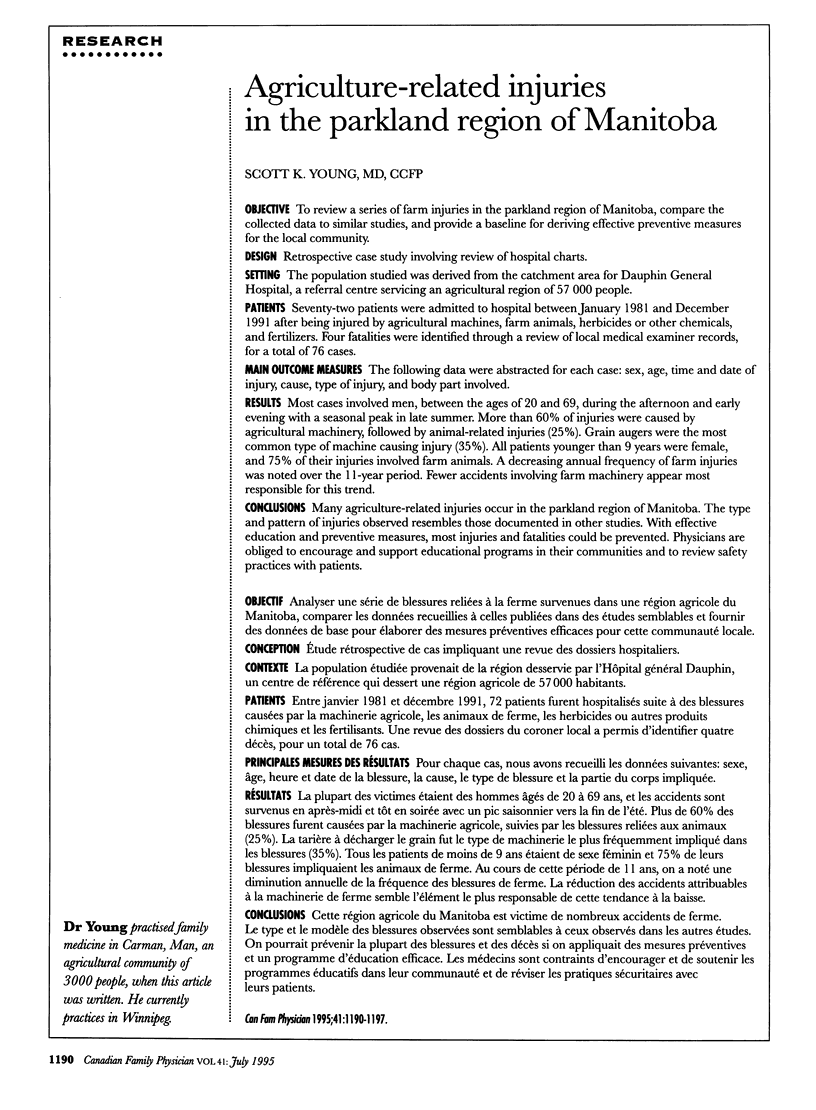


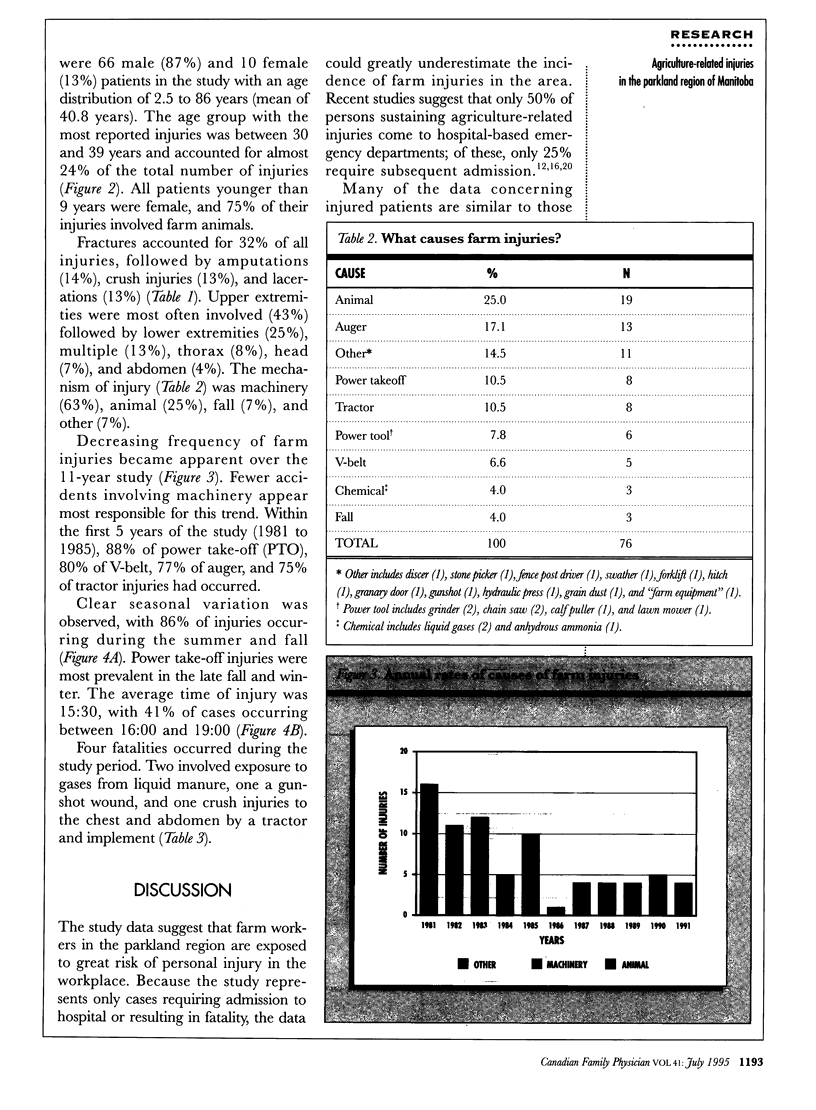

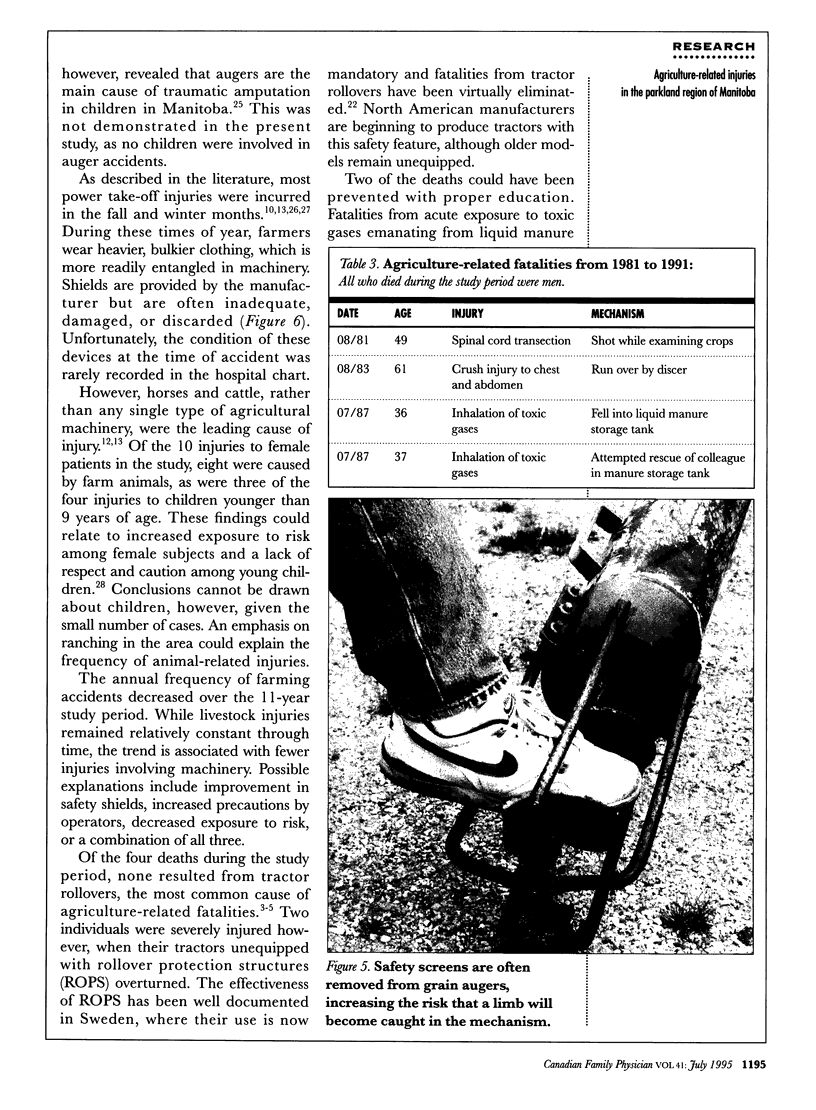
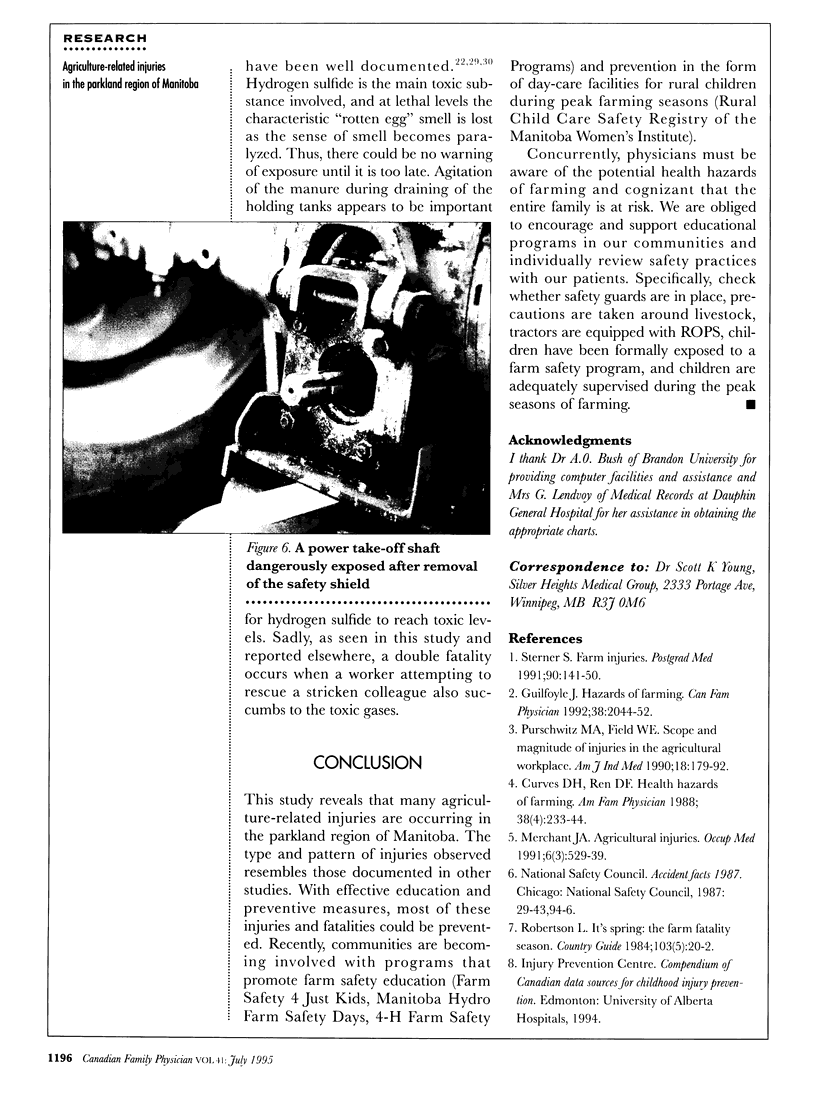
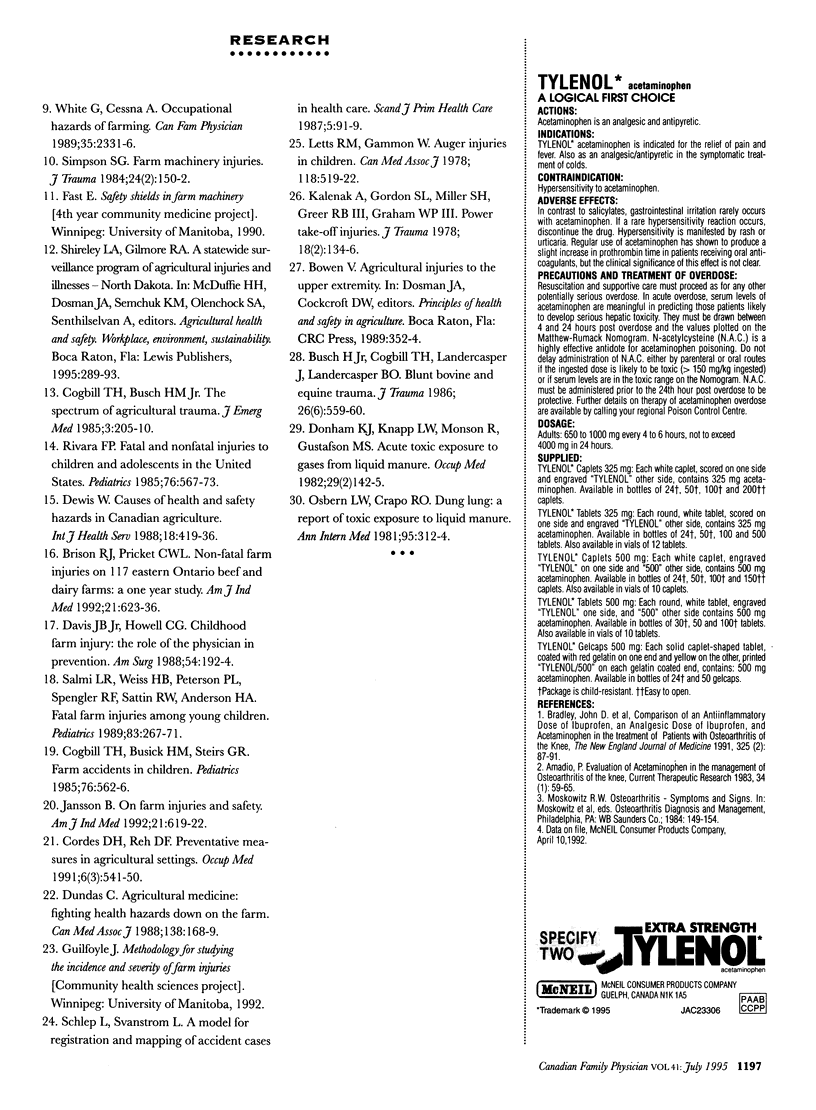
Images in this article
Selected References
These references are in PubMed. This may not be the complete list of references from this article.
- Brison R. J., Pickett C. W. Non-fatal farm injuries on 117 eastern Ontario beef and dairy farms: a one-year study. Am J Ind Med. 1992;21(5):623–636. doi: 10.1002/ajim.4700210503. [DOI] [PubMed] [Google Scholar]
- Busch H. M., Jr, Cogbill T. H., Landercasper J., Landercasper B. O. Blunt bovine and equine trauma. J Trauma. 1986 Jun;26(6):559–560. doi: 10.1097/00005373-198606000-00013. [DOI] [PubMed] [Google Scholar]
- Cogbill T. H., Busch H. M., Jr, Stiers G. R. Farm accidents in children. Pediatrics. 1985 Oct;76(4):562–566. [PubMed] [Google Scholar]
- Cogbill T. H., Busch H. M., Jr The spectrum of agricultural trauma. J Emerg Med. 1985;3(3):205–210. doi: 10.1016/0736-4679(85)90073-3. [DOI] [PubMed] [Google Scholar]
- Cordes D. H., Foster D. Health hazards of farming. Am Fam Physician. 1988 Oct;38(4):233–244. [PubMed] [Google Scholar]
- Davis J. B., Jr, Howell C. G., Parrish R. A. Childhood farm injury: the role of the physician in prevention. Am Surg. 1988 Apr;54(4):192–194. [PubMed] [Google Scholar]
- Donham K. J., Knapp L. W., Monson R., Gustafson K. Acute toxic exposure to gases from liquid manure. J Occup Med. 1982 Feb;24(2):142–145. [PubMed] [Google Scholar]
- Dundas C. Agricultural medicine: fighting health hazards down on the farm. CMAJ. 1988 Jan 15;138(2):168–169. [PMC free article] [PubMed] [Google Scholar]
- Guilfoyle J. Hazards of Farming: Injury statistics suggest methods of prevention. Can Fam Physician. 1992 Sep;38:2044–2052. [PMC free article] [PubMed] [Google Scholar]
- Jansson B. On farm injuries and safety. Am J Ind Med. 1992;21(5):619–622. doi: 10.1002/ajim.4700210502. [DOI] [PubMed] [Google Scholar]
- Kalenak A., Gordon S. L., Miller S. H., Greer R. B., 3rd, Graham W. P., 3rd Power take-off injuries. J Trauma. 1978 Feb;18(2):134–136. doi: 10.1097/00005373-197802000-00011. [DOI] [PubMed] [Google Scholar]
- Letts R. M., Gammon W. Auger injuries in children. Can Med Assoc J. 1978 Mar 4;118(5):519–522. [PMC free article] [PubMed] [Google Scholar]
- Merchant J. A. Agricultural injuries. Occup Med. 1991 Jul-Sep;6(3):529–539. [PubMed] [Google Scholar]
- Osbern L. N., Crapo R. O. Dung lung: a report of toxic exposure to liquid manure. Ann Intern Med. 1981 Sep;95(3):312–314. doi: 10.7326/0003-4819-95-3-312. [DOI] [PubMed] [Google Scholar]
- Purschwitz M. A., Field W. E. Scope and magnitude of injuries in the agricultural workplace. Am J Ind Med. 1990;18(2):179–192. doi: 10.1002/ajim.4700180210. [DOI] [PubMed] [Google Scholar]
- Rivara F. P. Fatal and nonfatal farm injuries to children and adolescents in the United States. Pediatrics. 1985 Oct;76(4):567–573. [PubMed] [Google Scholar]
- Salmi L. R., Weiss H. B., Peterson P. L., Spengler R. F., Sattin R. W., Anderson H. A. Fatal farm injuries among young children. Pediatrics. 1989 Feb;83(2):267–271. [PubMed] [Google Scholar]
- Schelp L., Svanström L. A model for registration and mapping of accident cases in health care. Scand J Prim Health Care. 1987 May;5(2):91–99. doi: 10.3109/02813438709013983. [DOI] [PubMed] [Google Scholar]
- Simpson S. G. Farm machinery injuries. J Trauma. 1984 Feb;24(2):150–152. doi: 10.1097/00005373-198402000-00011. [DOI] [PubMed] [Google Scholar]



